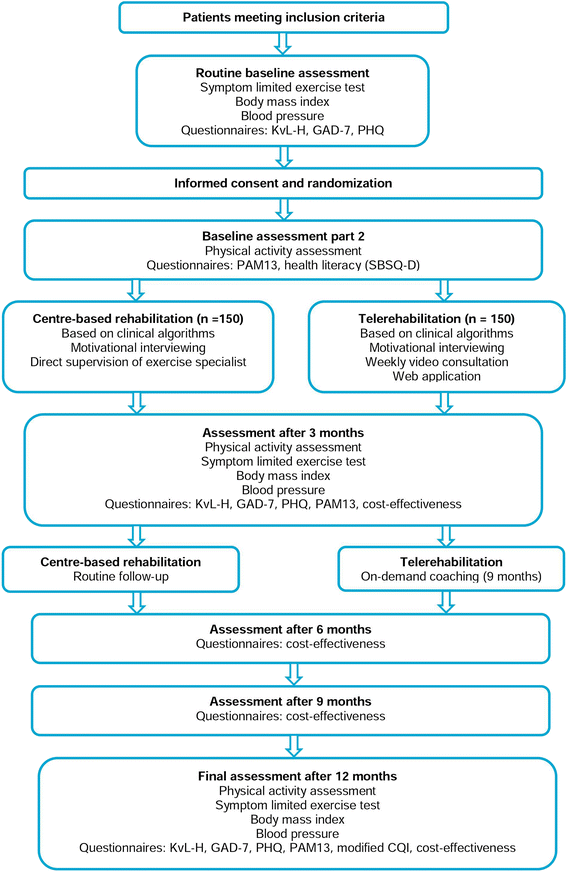Effects of cardiac telerehabilitation in patients with coronary artery disease using a personalised patient-centred web application: protocol for the SmartCare-CAD randomised controlled trial
- PMID: 28143388
- PMCID: PMC5282829
- DOI: 10.1186/s12872-017-0477-6
Effects of cardiac telerehabilitation in patients with coronary artery disease using a personalised patient-centred web application: protocol for the SmartCare-CAD randomised controlled trial
Abstract
Background: Cardiac rehabilitation has beneficial effects on morbidity and mortality in patients with coronary artery disease, but is vastly underutilised and short-term improvements are often not sustained. Telerehabilitation has the potential to overcome these barriers, but its superiority has not been convincingly demonstrated yet. This may be due to insufficient focus on behavioural change and development of patients' self-management skills. Moreover, potentially beneficial communication methods, such as internet and video consultation, are rarely used. We hypothesise that, when compared to centre-based cardiac rehabilitation, cardiac telerehabilitation using evidence-based behavioural change strategies, modern communication methods and on-demand coaching will result in improved self-management skills and sustainable behavioural change, which translates to higher physical activity levels in a cost-effective way.
Methods: This randomised controlled trial compares cardiac telerehabilitation with centre-based cardiac rehabilitation in patients with coronary artery disease. We randomise 300 patients entering cardiac rehabilitation to centre-based cardiac rehabilitation (control group) or cardiac telerehabilitation (intervention group). The core component of the intervention is a patient-centred web application, which enables patients to adjust rehabilitation goals, inspect training and physical activity data, share data with other caregivers and to use video consultation. After six supervised training sessions, the intervention group continues exercise training at home, wearing an accelerometer and heart rate monitor. In addition, physical activity levels are assessed by the accelerometer for four days per week. Patients upload training and physical activity data weekly and receive feedback through video consultation once a week. After completion of the rehabilitation programme, on-demand coaching is performed when training adherence or physical activity levels decline with 50% or more. The primary outcome measure is physical activity level, assessed at baseline, three months and twelve months, and is calculated from accelerometer and heart rate data. Secondary outcome measures include physical fitness, quality of life, anxiety and depression, patient empowerment, patient satisfaction and cost-effectiveness.
Discussion: This study is one of the first studies evaluating effects and costs of a cardiac telerehabilitation intervention comprising a combination of modern technology and evidence-based behavioural change strategies including relapse prevention. We hypothesise that this intervention has superior effects on exercise behaviour without exceeding the costs of a traditional centre-based intervention.
Trial registration: Netherlands Trial Register NTR5156 . Registered 22 April 2015.
Keywords: Behavioural change; Cardiac rehabilitation; Cost-effectiveness; Patient empowerment; Physical activity; Telerehabilitation.
Figures
References
-
- Roffi M, Patrono C, Collet JP, Mueller C, Valgimigli M, Andreotti F, et al. 2015 ESC Guidelines for the management of acute coronary syndromes in patients presenting without persistent ST-segment elevation: Task Force for the Management of Acute Coronary Syndromes in Patients Presenting without Persistent ST-Segment Elevation of the European Society of Cardiology (ESC) Eur Heart J. 2016;37(3):267–315. doi: 10.1093/eurheartj/ehv320. - DOI - PubMed
-
- Revalidatiecommissie NVVC / NHS, Projectgroep PAAHR . Multidisciplinaire Richtlijn Hartrevalidatie 2011. Utrecht: Nederlandse Vereniging Voor Cardiologie; 2011.
Publication types
MeSH terms
Associated data
LinkOut - more resources
Full Text Sources
Other Literature Sources
Medical
Miscellaneous


